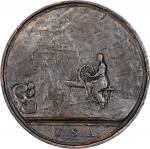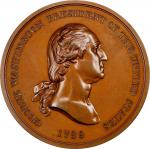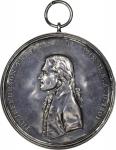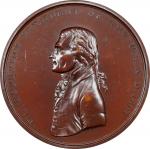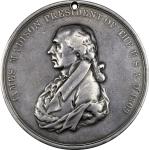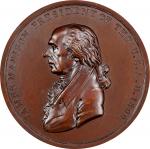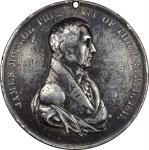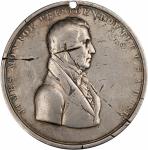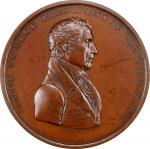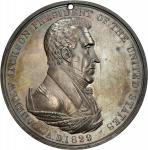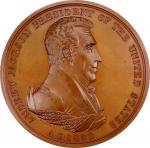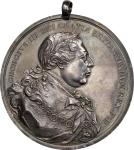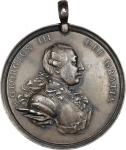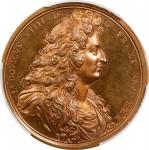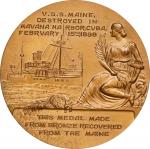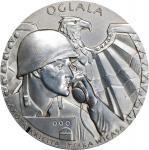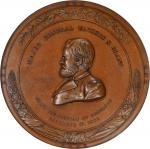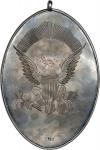1795 George Washington Indian Peace Medal. Silver, Hand Engraved. Second Size. By Joseph Richardson, Jr. Prucha-33. Choice Extremely Fine. 104.9 mm x 149.5 mm, without the hanger, which extends an additional 9.1 mm from the upper border of the oval. 1971.9 grains. A simply magnificent medal to behold and a truly remarkable survivor that has clearly been revered since the day it was presented, likely on August 8, 1795. The surfaces exhibit a microscopic granularity suggestive of a finishing treatment by the maker, which seems to have preserved some of the fine metal displacement along the lines of the engraving. These fine details might not have survived heavy polishing, which this medal does not seem to have ever endured. Engraved by hand on both sides on a single thin plate of silver, averaging 1.0 mm thick, and then banded around in finishing. The banding around and the suspension loop are made of the same drawn wire, shaped on the same custom engineered wire drawing bench. The distinctive shape of the banding, with a prominent central ridge, is purpose driven rather than ornamental. In opposition to that ridge is a channel designed for the secure seating of the oval plate. This structure is clearly visible within the suspension loop affixed at the top. The border band is closed at a single joint, directly at 12 oclock, which is overlapped by the soldering of the suspension loop and thus almost invisible without close study. While seemingly fragile due to the thinness and size of the medal, this is actually a very well-constructed work with only a single point of potential failure and a solid plate of silver secured within. In this case, the assembly is completely intact.
The bright-cut engraving was clearly completed by a masterful artisan, in fine style, and the singular IR punch of Joseph Richardson, Jr. is sharply applied to the lower reverse. The punch itself was broken at the lower left corner, and this distinctive punch has been seen on other works from Richardsons workshop, attributed to Joseph Richardson, Sr., but identified as a punch that was also used in a later state by the junior Richardson. The engraved lines create a remarkable depth of field in their application, resulting in an almost three-dimensional composition. It is stunning in hand, and the superb surfaces accentuate the visual appeal. A single thin scratch of considerable age is noted in the lower obverse field, but other marks are superficial at worst and virtually all require some study to find. The gently reflective surfaces are medium to deep gray, with slight mottling of pale blue and champagne gold on both sides. Again, the degree of preservation seen here is incredible.
The oval Peace medals of the Washington administration stand out from all the others to follow by more than simply their size, shape, and rarity. They were each hand-engraved, thoughtfully cut by a skilled silversmith putting his graver to a silver plate with the goal of representing sentiments of friendship at a remarkably historic moment in time. The United States began to officially operate under the authority of the Constitution on March 4, 1789, making the oval Peace medals the first such awards confirmed to have been officially presented by a very young nation to leaders of indigenous nations. It was clearly desired that these pieces be works of art, accomplished in fine style worthy of diplomatic presentation, and just as worthy of being proudly displayed by their recipients. The results followed the desires, as these were beautifully made and it is known that they were prized. In the case of one known recipient, Red Jacket of the Seneca, it has been written that he "so cherished the medal that he is said to have worn it every day until his death." Some were buried with their owners, an act representing a remarkable elevation of status from an object of material culture to one perceived to retain significance in the realm of the Spirit World.
While internment is known to have been the fate of some of these medals, it is not the case that all of them met that end, and this is clearly among those that did not. There is no mistaking that the surfaces of this piece show no evidence of such elemental exposure. Indeed, this is among those likely passed down through the living generations as venerated symbols of status. Each of these medals is a marker of one persons role in the dynamic history that unfolded when two drastically different cultures met and strove to sort out their differences and interests. Today, we have the benefit of looking backward through time to understand what transpired, but at the time, the situation was novel and fluid, and the outcome uncertain.
As with any Peace Medal, provenance is what ties the object to its human story most intimately, and it is this detail that is most often lost. We do know with certainty that this medal was awarded by the first administration of George Washington to someone of great importance amongst the indigenous nations on the American frontier. The identity of that person is difficult to ascertain with certainty, as is the case with nearly all of the early Peace Medal awards. The most solid provenance of any surviving example is probably that given to Red Jacket in 1792. Most of the others, even those with "known" provenances, rely on precious little documented contemporary evidence that can unquestionably confirm a direct provenance to a recipient.
<strong>Distribution of the Washington Ovals, the Miami and the Treaty of Greenville</strong>
Contrary to conventional wisdom regarding the distribution of Peace medals, the ovals of the Washington administration were not necessarily given at treaty signings. We know of at least two well-documented cases where medals were given without connections to treaties, that of Red Jacket, and the medals given to Chiefs of the Chickasaw Nation in 1792 and 1794. In the former case, Red Jacket would not sign a treaty with the United States until the 1794 Treaty of Canandaigua, and in the case of the Chickasaw, treaties were signed in 1786 and not again until 1801. Documentation of specific presentations of oval medals at treaty signings are difficult to find. However, there is one important instance where the transfer of oval medals is known to have occurred at a treaty signing, and that is at the 1795 Treaty of Greenville, signed August 3, 1795. According to the text of the document, the Treaty was "between the United States of America and the Tribes of Indians called the Wyandots, Delawares, Shawanoes, Ottawas, Chipewas, Putawatimes, Miamis, Eel River, Weeas, Kickapoos, Piankashaws and Mishashaws." Among the signers for the "Miamis" were Me-She-kun-nogh-quoh, or Little Turtle, a War Chief who was the primary speaker at Greenville on behalf of his people, and Jean Baptiste Richardville, who was present on behalf of his uncle Pacanne, the head Chief of the Miami.
The Miami people of the late 18th century were occasionally referred to as the "Miami Confederation" or the "Wabash Confederacy," terms that misinterpreted the relationships of the various bands that comprised them. The Miami of that period are probably best understood today as a group of six bands sharing close cultural attributes, including language, having settlements in close proximity, and practicing general cooperation. Each band had its own Chief hierarchy, with the head Chief of the Atchakangoeun band being considered of the highest ranking. Chiefs of other bands would defer to him when opportunities arose. The Eel River, Wea, and Piankashaw groups specified in the Treaty of Greenville were all bands of the greater Miami peoples. Other bands were included under the general label "Miami" on the document. Those included the already mentioned Atchakangouen, the largest Miami band, along with the Pepikokia and Mengakonkia bands.
The signers under the "Miami" identifier included Jean Baptiste Richardville, who signed for the Atchakangoeun (though he was a deputy head Chief, as noted), Le Gris, as Chief of the Pepikokia, and Little Turtle, the head War Chief of the Atchakangoeun. White Loon, a deputy War Chief at the time and a son-in-law of Little Turtle, also signed.
Among the 1,130 indigenous participants in the council at Greenville, there were 73 "Miamies [sic] and Eel Rivers" recorded as present. Medals would have only been presented to signatories, reducing substantially the number of Miami leaders who would have received a medal like this at Greenville. In total, there were nine signatories representing the various Miami bands. According to the minutes and proceedings of the Treaty of Greenville, submitted by General Anthony Waynes secretary and first aide-de-camp Henry DeButts on September 20, 1795, "The medals and silver ornaments &c. were delivered" on the afternoon of August 8th, 1795. It is clear that medals were distributed at this signing. Both of the previous public offerings of this medal identified it as an award to a Miami Chief.
<strong>The Little Turtle Provenance</strong>
Since our offering of this medal in 1988, it has been known as the "Little Turtle medal," attributed by the writer at that time to that famous Miami Chief-the best known of his people. That was the first time this medal was assigned the Little Turtle provenance in an auction appearance, though it was referred to Little Turtles as early as 1963 when its loan to the Western Reserve Historical Society was announced in local newspapers. However, no clear evidence was presented as to why that determination was made, leaving us to assume that someone had made a convincing historical connection leading to that conclusion, perhaps staff at the Western Reserve Historical Society where this piece had been on loan for a time in the 1960s. Unfortunately, any records they might have are unavailable for at least a year due to a fire in the facility. Whatever the case, the fact remains that someone was convinced enough to put this in print. Historically speaking, the ability for a researcher to dig deeper has long been limited by lack of ready access to information, something thankfully much less of a problem in the digital age. As such we have endeavored to prove the Little Turtle provenance through considerable study of original source documents and the research of others over the years, now in large part accessible at ones literal fingertips. Little Turtle is undeniably a possible recipient of this medal, and some weight must be given this conclusion in consideration of the published statements of 1963 and 1988.
<strong>Little Turtles Grave</strong>
Since Little Turtle has been published as a possible recipient of this medal, it is worth noting that Little Turtles grave was discovered and unearthed in 1911, a few years after the Chapman brothers bought this piece and sold it to William H. Hunter, in 1906. As noted previously, many of these medals were interred with their recipients, but the presently offered medal was clearly not. Neither was Little Turtles. As such, the facts relating to Little Turtles grave are circumstantially supportive of the Little Turtle provenance for this medal.
In 1917, just six years after the discovery of Little Turtles final resting place, Calvin M. Young published a book on the Chief, <em>Little Turtle, The Great Chief of the Miami Indian Nation</em>. Therein is a remarkable and very useful account of the graves discovery, found accidentally on July 4th, 1911. Two brothers, while excavating a site for a home, happened upon "a number of Indian skeletons in digging out the cellar…noticing that whatever was in the graves was appropriated by laborers, the contractors called off the crew and with the assistance of Dr. Gillie [whose home was to be built], proceeded to finish the cellar and to dig the drain for the same. In this cellar drain, the grave of Little Turtle was found."
What is most notable in this account is that the grave of Little Turtle (determined to be such at a later point) was uncovered after the contractors noted that grave goods were being taken by their laborers and after they removed those laborers from the project. So it appears that there was not only concern about artifacts being lost, but it came at a point that served to preserve the yet undiscovered resting place of the Chief. The account helpfully continues to list the items found with a welcomed degree of specificity: "Eight silver bracelets; two silver anklets; one heavy metal bracelet; three silver medals; four silver brooches; one pair of silver ear rings; six pendants; one string of silver beads; twenty-three silver crosses, each one inch long; one sword, which we are certain is that presented to the Chief by General Washington [presented in November 1796, in Philadelphia]; one string of white silver beads; four metal buttons; one small pocket knife; one large clasp knife, of good design; one drinking cup; one metal spoon; one pair of shears; one hammer; one gun barrel from which rotten portions of the stock fell when lifted from the grave; one pair of bullet molds; one flint lock; the remains of a pistol; three large knives; one pair of steel spurs; one ax; one tomahawk, and a copper kettle…"
Of greatest interest here, of course, are the "three silver medals," and to a lesser degree, the sword. Fortunately, the items removed from Little Turtles site were illustrated in Youngs book, in 1917, and an illustration includes what are described as the three silver medals. While it is not possible to tell from the images what medals these are, or if they are medals at all, what is abundantly clear and beyond challenge is that none of the three is an oval Washington Peace Medal. These are clearly round objects, the largest of which could be as large as a first-size Jefferson medal, but a Washington oval is certainly not among them. Further, Young himself wrote of the Washington oval, "It was not interred with him at his burial, as its absence was especially noticed from all of the other things that were taken from the grave. Its present location seems to be entirely unknown to any person now living." Little Turtle is known to have signed at least three treaties beyond that of Greenville in 1795. These were the Treaty of Fort Wayne, June 7, 1803, the Treaty of Vincennes, August 21, 1805, and the Treaty of Fort Wayne, September 30, 1809. The three round medals documented in the grave find might well correspond to these later treaty signings. As for the sword gifted to Little Turtle by Washington, that gift came more than a year after the signing at Greenville. What is notable here is that Washington presented a sword instead of what would have been customary as a sign of friendship and alliance, a Peace Medal. This suggests that Little Turtle was likely already the recipient of one of the medals from Washington-that transferred at Greenville.
<strong>The Hunter Provenance</strong>
The first public offering of this medal was in the sale of William H. Hunters extensive coin and medal collection conducted by Samuel Hudson Chapman in December 1920. Therein, Chapman assigned the provenance of this medal to "Mississinewa, Chief of the Wabash Miamis." Closing his description was a more detailed history, which we have reorganized into chronological order for clarity:
President Washington to Chief Mississinewa of the Miamis, 1795; Daughter of Chief Mississinewa, by descent; gifted to Judge Allen of Wabash, Indiana, 1826; Grandson of Judge Allen, by descent; sold to H.M. Brenneeke of Nashville, Tennessee, about 1890; to S.H. and H. Chapman, October 1905; William H. Hunter, Esq., of Toronto, August 2, 1906.
Significantly, Chapmans description noted that "original memoranda to the above facts accompany the medal." It is not stated in whose hand those memoranda were, but it is notable that some documentation attesting to the provenance seems to have accompanied the medal in 1920.
This provenance is markedly different from "Little Turtle," so the obvious first step was to figure out how these two published provenances could be one in the same, which proved highly improbable. Most notably, we failed to find any reference to a "Chief of the Wabash Miamis" named Mississinewa, though this entry yields an important clue that will be addressed later. Little Turtles eldest daughter, who had married the famed interpreter William Wells, died in 1805 and could not have passed the medal to another party in 1826. His youngest daughter seems to have lived in the area, but little is known of her beyond her marriage to White Loon, and the fact that her husband likely died around 1839. She seems to have resided just outside of present-day Fort Wayne, Indiana. We have not been able to determine the identity or relevance of "Judge Allen of Wabash," though there seems to have been a judge by the name of James C. Allen living in the area in the 1870s.
The remainder of the provenance is probably precisely accurate considering that Samuel Hudson Chapman wrote the 1920 sale and was apparently involved, with his brother, in the direct sale of this medal to Hunter in 1906. H.M. Brenneeke was a Nashville businessman involved in the resurrection of the Tennessee State Fair as a charter member of the Tennessee State Fair Association. The Association raised $120,000 to purchase a site for the event in late 1905 or early 1906. Interestingly but perhaps only circumstantially relevant, this period of fundraising, of clear interest to Brenneeke, corresponds directly to the time he is reported to have sold this medal to the Chapmans. His fundraising efforts might well have been the impetus for such a sale.
<strong>Chief Jean Baptiste Richardville</strong>
As mentioned previously, Chief Jean Baptiste Richardville (Pee-Jee-wá) was another Miami signer of the Treaty of Greenville in 1795, and almost certainly a recipient of a 1795-dated oval, alongside Little Turtle. He was present at Greenville on behalf of his uncle, Pacanne, head Chief of the Atchakangoeun band and the primary Chief of the Miami people. As dictated by kinship rules and hereditary transfers of titles within the Miami, as Pacannes nephew, Richardville was a prospective heir to his title. After Pacanne died in 1816, Richardville became the primary Chief of the Miami, remaining so until his own death, in 1841.
On October 23, 1826, the Miami signed a treaty with the United States, formally referred to in the text of the ratified document, "A Treaty between the United States of America and the Miami Tribe of Indians…made and concluded near the mouth of the Mississinewa, upon the Wabash, in the State of Indiana…" As such, the text in this very document is almost identical to the Hunter provenance which erroneously identified "Mississinewa" as the name of a chief rather than that of the river (or a Miami subgroup, which it was at the time). Furthermore, it is worth noting that the date of the treaty, 1826, corresponds precisely to the date the medal was supposedly given by the chiefs daughter to "Judge Allen." While this might be a simple coincidence, it might also speak to confusion of information presented regarding the provenance a century ago.
The terms of the treaty ceded considerable Miami lands in Indiana to the United States, lands which had largely been guaranteed to remain under indigenous control by previous treaties signed with the United States. As part of the terms, the United States specified tracts of land to be retained by several of the senior members of the Miami, including Richardville, as well as houses, money, and livestock. Many Miami moved to the western Indian Territories by necessity, but a few, such as a considerable number of Richardvilles family remained on or near ancestral lands in Indiana. Chief Jean Baptiste Richardville was a signatory on the 1826 Treaty of Mississinewa as the head Chief of the Miami. In large part the result of this treaty which favored him, it was said that later in his life, he was the wealthiest man in Indiana.
The prominent status of Chief Richardville and his signature on the 1826 Treaty of Mississinewa render him a probable match to the Hunter provenance that is difficult to deny. The fact that he was almost certainly a direct recipient of a 1795 oval Washington Peace Medal at the Treaty of Greenville, makes him an excellent candidate as the original recipient of this medal.
In either case, what is certain is that this medal was an award of great significance from the first President to a frontier Chief of high esteem. It almost certainly relates to the signing of the famous Treaty of Greenville in 1795, and was likely originally given to one of the two persons discussed here.
<strong>The Washington Ovals</strong>
As noted above, the oval Peace medals distributed by the administration of George Washington are the first in this long-standing American tradition, adopted from the British, French and Spanish before them. It is unknown how many were produced and distributed, but we know that each was thoughtfully hand-made and served as an official gift of considerable significance to a Chief of high status. Very few are known today and among those known, few are in private hands.
The ovals dated 1789, 1792, 1793 and 1795 can be categorized into three groups, as follows:
1 - Those dated 1789. These are styled much differently than the medals bearing later dates. Only two or three are known, but only one seems to be of relatively fine style. None are known with indigenous provenance. None cataloged as genuine by other writers is in private hands.
2 - The standard medals of 1792, 1793 and 1795, each with the same motif, and each presumably issued in three sizes, though no "first size" medals of 1795 are known of this type. These seem to be the adopted official type, and several are believed to have indigenous provenance. One, that given to Red Jacket, has a very tight chain of ownership back to the original presentation.
3 - The "Treaty of Greeneville" [sic] medal of 1795. This is styled differently, and bears the specific date of the Treaty signing (though, not the ratification). It could not have been prepared in advance and distributed at the Treaty signing, as the exact date would have been uncertain until completed. It also has the Arms of the United States on both sides, and lacks the most significant iconography, the scene with two "heads of state" on equal terms, in a peaceful exchange. This is the only element of the standard medals that would have carried meaning for the recipients. Indeed, these motifs relate directly to topics raised by the indigenous participants at the Greenville proceedings. Only a single example is believed to exist, and it seems likely a one-off commemorative production.
As such, for the purpose of discussing what is known to exist in this series as relates to the present medal, we are including only the medals of category #2 above. About a dozen examples of the 1792 medals have been documented by the writer, with perhaps three in private hands, and only one appearing for sale in a major auction since 1936.
The issues of 1793 are slightly more "common" with about 16 documented. Perhaps only four remain in private hands. One of these was simply reported by Belden in 1927, was unplated, and is thus uncertain. Another has not appeared publicly since 1946.
The standard issues of 1795, as offered here, are by far the rarest. Just three medals are believed to exist for this date, with a reported fourth being highly suspect. No first-size medals are known, and it is unclear that they ever existed (a 1795 entry in the Joseph Richardson papers references an order for arm bands, wrist bands, and two sizes of medals). This is one of only two second-size examples known, and a lone third-size medal also survives. Interestingly, the single third-size medal also carries a provenance to a known signer of the Treaty of Greenville, White Loon, mentioned earlier. It makes sense that he might have received a smaller size as he was not a leading Chief of any of the six Miami bands. Just two of the 1795-dated medals are believed to be held privately.
We have not offered a genuine Washington oval since May 2004, where, under the Stacks aegis, a third-size 1792 was sold into the Partrick Collection and is now in the permanent collection of Colonial Williamsburg. The Donald Partrick Collection included five examples in 2021, which on its face suggests that any one of this small handful could present itself in the coming years. However, those records are misleading because three of the Partrick medals are no longer in private hands and will unlikely ever be offered for sale again. Still, the Partrick offerings are significant, having established modern pricing for these immensely historic and prized objects that are rarely ever seen, let alone sold. The record price attained for a Washington oval in the Partrick sales was $630,000 for a second-size 1793 with a provenance to the 1920 Hunter Cabinet. In Hunter, this medal was the next lot and it realized 45% more, setting the price record for the entire auction. As noted earlier, the 1795 issues are considerably rarer, and this has not been offered for sale in 35 years.
<strong>Included with this lot will be a small selection of prints relating to the Treaty of Greenville (including actual-size color images of the Treaty), and photocopies of documents relating to the subject. These will be forwarded to the winning bidder upon request.</strong> From the Ronald A. Slovick Family Collection. Earlier presented by the administration of George Washington for the Treaty of Greenville, August 8th, 1795, likely to Chief Little Turtle or Chief Jean Baptiste Richardville, both of the Miami; reportedly the daughter of the recipient, by descent; uncertain intermediaries; H.M. Brenneeke of Nashville, Tennessee, about 1890; to S.H. and H. Chapman, October 1905; William H. Hunter, Esq., of Toronto, August 2, 1906; S.H. Chapmans sale of the W.H. Hunter Collection, December 1920, lot 91; Virgil M. Brand (Brand Secondary Ledger 17, #103,783); New Netherlands Coin Company, 1955; Mrs. R. Henry Norweb; loaned to Western Reserve Historical Society, as of 1963; our (Bowers and Merenas) Everson and Faught Collections sale, June 1988, lot 797.

